Naming transition metals - Study guides, Class notes & Summaries
Looking for the best study guides, study notes and summaries about Naming transition metals? On this page you'll find 30 study documents about Naming transition metals.
All 30 results
Sort by
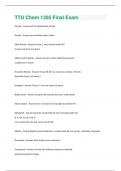 Popular
Popular
-
TTU Chem 1305 Final Exam Questions With All Correct Answers!!
- Exam (elaborations) • 14 pages • 2024
- Available in package deal
-
- $7.99
- 1x sold
- + learn more
Periods - Answer-left to right-gradual change Groups - Answer-up and down-super similar Alkali Metals - Answer-Group 1: Very reactive with H2O Usually only form one bond Alkaline-Earth Metals - Answer-Group 2: More stable than group 1 usually form 2 bonds Transition Metals - Answer-Group 3B-2B: Can make any number of bonds Bond like Group 1 & Group 2 Halogens - Answer-Group 7: Can only make one bond Noble Gases - Answer-Group 8: Nonreactive and can't make bonds Atomic Status - Answer-S...
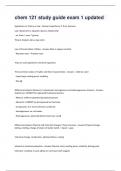
-
chem 121 study guide exam 1 updated Rated 100% Correct!!
- Exam (elaborations) • 5 pages • 2024
- Available in package deal
-
- $7.99
- + learn more
Hypothesis vs Theory vs Law - Answer-Hypothesis: If, then, because Law: Statement or equation about a relationship - ex: force = mass * gravity Theory: Explains why a law exists Law of Conservation of Mass - Answer-Mass is always constant - Reactant mass = Product mass They are used (upheld) in chemical equations Three common states of matter and their characteristics - Answer-- Solid (s): color - Liquid (aq): melting point, solubility - Gas (g): Difference between Elements, Compounds,...
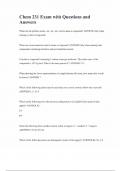
-
Chem 231 Exam with Questions and Answers
- Exam (elaborations) • 10 pages • 2024
-
- $7.99
- + learn more
Chem 231 Exam with Questions and Answers When are the prefixes mono-, di-, tri-, etc. used to name a compound? ANSWER Only when naming covalent compounds When are roman numerals used to name a compound? ANSWER Only when naming ionic compounds containing transition and post-transition metals Consider a compound containing 3 carbon atoms per molecule. The molar mass of the compound is 167.9 g/mol. What is the mass percent C? ANSWER 21.5 When drawing the Lewis representation of a single...
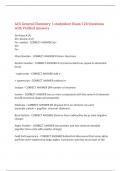
-
ACS General Chemistry 1 studysheet Exam 124 Questions with Verified Answers,100% CORRECT
- Exam (elaborations) • 10 pages • 2024
-
- $11.99
- + learn more
ACS General Chemistry 1 studysheet Exam 124 Questions with Verified Answers 56=Mass # (A) 26= Atomic # (Z) Fe= symbol - CORRECT ANSWER 56= 26= Fe= Mass Number - CORRECT ANSWER Proton+ Neutrons Atomic Number - CORRECT ANSWER # of protons/electrons (equal in elemental form) - superscript - CORRECT ANSWER Add e- + superscript - CORRECT ANSWER subtract e- Isotope - CORRECT ANSWER Diff number of neutrons Isomer - CORRECT ANSWER two or more compounds with the same # of elemen...
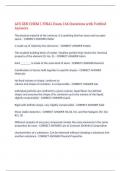
-
ACS GEN CHEM 1 FINAL Exam 166 Questions with Verified Answers,100% CORRECT
- Exam (elaborations) • 14 pages • 2024
-
- $11.99
- + learn more
ACS GEN CHEM 1 FINAL Exam 166 Questions with Verified Answers The physical material of the universe. It is anything that has mass and occupies space. - CORRECT ANSWER Matter is made up of relatively few elements. - CORRECT ANSWER Matter The smallest building block of matter. Smallest particle that retains the chemical property of the element (O, He, S). - CORRECT ANSWER Atom Each _______ is made of the same kind of atom - CORRECT ANSWER Element Combination of atoms held together i...
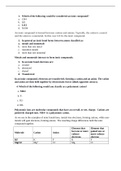
-
CHEM 120 Week 2 Questions and Answers- Chamberlain College Atlanta
- Exam (elaborations) • 10 pages • 2023
-
Available in package deal
-
- $10.98
- + learn more
CHEM 120 Week 2 Questions and Answers- Chamberlain College Atlanta 1. Which of the following would be considered an ionic compound? a. CH4 b. SO c. LiCl d. N2O4 An ionic compound is formed between cations and anions. Typically, the cation is a metal and the anion is a nonmetal. In this case LiCl is the ionic compound. 2. In general an ionic bond forms between atoms classified as: a. metals and nonmetals b. more than one metal c. transition metals d. more than one nonmetal Metals and...
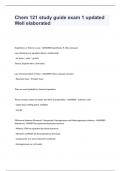
-
Chem 121 study guide exam 1 updated Well elaborated
- Exam (elaborations) • 6 pages • 2023
-
Available in package deal
-
- $12.99
- + learn more
Hypothesis vs Theory vs Law - ANSWERS Hypothesis: If, then, because Law: Statement or equation about a relationship - ex: force = mass * gravity Theory: Explains why a law exists Law of Conservation of Mass - ANSWERS Mass is always constant - Reactant mass = Product mass They are used (upheld) in chemical equations Three common states of matter and their characteristics - ANSWERS - Solid (s): color - Liquid (aq): melting point, solubility - Gas (g): Difference between Elements...
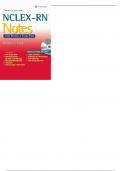
-
NCLEX-RN Notes Core Review And Exam Prep
- Exam (elaborations) • 281 pages • 2023
-
Available in package deal
-
- $29.96
- + learn more
BASICS BASICS ■ Challenging, defensive, or disapproving responses ■ Direct probing and “how” and “why” questions ■ Interruptions, environmental noise, or extremes in temperature ■ Trite, common expressions (clichés) Leadership Leadership and Management Terms ■ Accountability: Answerable for actions/judgments regarding care ■ Autonomy: Nurse can make independent decision to decide/act ■ Case management: Coordination of int...
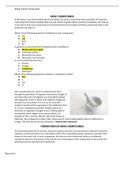
-
CHEM 120 Week 2 Ionic Compound Q/A 98%
- Exam (elaborations) • 8 pages • 2022
-
- $11.49
- + learn more
IONIC COMPOUNDS In this lesson, you will be exploring ionic bonding. You have encountered many examples of molecules containing Ionic bonds including table salt and sodium fluoride which is found in toothpaste. We will see in this lesson how ionic compounds are formed and how the formation of these compounds leads to the properties we observe. Which of the following would be considered an Ionic Compound? A. CH4 B. LiCl C. N2O4 D. SO In general, an ionic bond forms between atoms classifi...
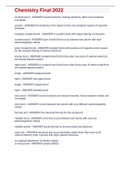
-
Chemistry Final 2022
- Exam (elaborations) • 10 pages • 2022
-
- $9.99
- + learn more
covalent bond - ANSWER bonds formed by sharing electrons, often occur between nonmetals polarity - ANSWER the tendency of an object to form two localized regions of opposite character nonpolar covalent bond - ANSWER A covalent bond with equal sharing of electrons. covalent bond - ANSWER type of bond that occurs between two atoms with high electronegativity values polar covalent bond - ANSWER covalent bond with positive and negative ends caused by the unequal sharing of valence electr...

How much did you already spend on Stuvia? Imagine there are plenty more of you out there paying for study notes, but this time YOU are the seller. Ka-ching! Discover all about earning on Stuvia


